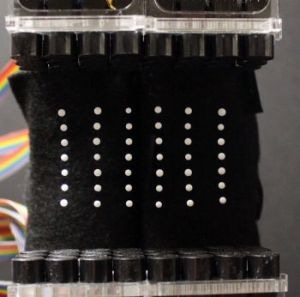Oct 14 2016
 The pixels are levitated using a series of miniature ultrasound speakers that create high-pitched and high-intensity soundwaves that are inaudible but forceful enough to hold the spheres in place. They can be spun and flipped using electric force fields. Credit: University of Sussex
The pixels are levitated using a series of miniature ultrasound speakers that create high-pitched and high-intensity soundwaves that are inaudible but forceful enough to hold the spheres in place. They can be spun and flipped using electric force fields. Credit: University of Sussex
Researchers have developed a mid-air display of ‘floating pixels’. Researchers from the Universities of Sussex and Bristol have employed soundwaves to lift several small objects at once even before the objects could be spun and flipped using electric force fields.
JOLED is a technology that changes small, multi-colored spheres into real-life pixels in an efficient manner. These pixels are capable of forming into floating displays or bringing computer game characters to life as physical objects.
This research will be presented next week at a future technologies conference happening in Japan. It aims to introduce new possibilities for game and mobile designers, providing them with a new method that will help represent digital information in a physical space.
Professor Sriram Subramanian, in the University of Sussex’s School of Engineering and Informatics, is the head of lab behind this study.
We’ve created displays in mid-air that are free-floating, where each pixel in the display can be rotated on the spot to show different colours and images. This opens up a whole new design space, where computer and mobile displays extend into the 3D space above the screen.
Professor Sriram Subramanian, University of Sussex
The pixels are suspended using a series of miniature ultrasound speakers that have the potential to produce high-intensity and high-pitched soundwaves that are inaudible yet forceful enough to hold the spheres in place.
The pixels are provided with an electrostatic charge by a thin coating of titanium dioxide, enabling them to be controlled in mid-air by modifications carried out to an electric force field, developed by small electrodes.
The most exciting part of our project is that we can now demonstrate that it is possible to have a fully functioning display which is made of a large collection of small objects that are levitating in mid-air. JOLED could be like having a floating e-ink display that can also change its shape.
Dr Deepak Sahoo, Research Associate, University of Sussex
The paper is the very first to reveal a fine level of monitoring over these levitating pixels, taking the technology much closer to something that could soon be used in galleries or theme parks.
For instance, in the future this display could be used in a public park to demonstrate to users the changing and complex patterns of carbon footprints of different countries, or varied currency fluctuations in different regions of the world. This will enable the general public to clearly view the multi-dimensional data and then interact with it.
Asier Marzo, research associate in the Department of Mechanical Engineering at the University of Bristol, explained: “Traditionally, we think of pixels as tiny color-changing squares that are embedded into our screens. JOLED breaks that preconception by showing physical pixels that float in mid-air.
“In the future we would like to see complex three-dimensional shapes made of touchable pixels that levitate in front of you.”
In the future we plan to explore ways in which we can make the display multi-colored and with high color depth, so we can show more vivid colors. We also want to examine ways in which such a display could be used to deliver media on-demand. A screen appears in front of the user to show the media and then the objects forming the display fall to the ground when the video finishes playing.
Professor Sriram Subramanian, University of Sussex
JOLED: A mid-air display based on electrostatic rotation of levitated Janus objects
Interact Lab/Youtube.com